Pet owners searching for an apartment know it can sometimes be difficult finding a landlord willing to rent to you and your dog or cat. But once you find the perfect place, there are certain precautions you should take before signing your name to a lease and moving in.
Landlords are not necessarily skeptical of people with dogs or cats. Responsible pet owners are usually responsible tenants, and landlords who permit pets know they have a larger pool of prospective tenants to draw from — especially ones who are likely to stay longer if they feel their pets are welcomed.
But renters have their own burden. If a landlord is reluctant to rent for any reason, you may have to prove that you and your pet can live within set guidelines and be good tenants.
You should also read and understand the fine print regarding pets — size and weight restrictions, policies about barking, the number of dogs or cats you’re permitted to own — plus security and cleaning deposits you’ll have to pay. In recent years, some landlords have even begun charging pet rent; it’s possible you may be charged $30 a month for your pet, in addition to deposits.
Your ability to prove that you care for your dog may be what gets you through the front door — and it could be what keeps you there.
First, read the lease thoroughly, especially the parts that relate to your pet. Make sure your dog or cat (or parakeet or snake, for that matter) fits within the limits established in the lease. If the apartment only allows small dogs and you own a Golden Retriever or a larger mixed breed, ask for an allowance — and then make sure it’s written into the lease and initialed by you and the landlord. But negotiating might not always work. For instance, if a landlord does not allow a specific breed of dog because it can be known to be dangerous, don’t expect him to stretch the rules.

“If you set a policy, as a rental owner you have to apply that policy to everybody,” says Eric Wiegers, deputy director of the California Apartment Association, a trade group that represents owners. “If you treat one applicant one way, you have to treat every applicant the same way.”
Be sure that you understand any required deposits (Wiegers said it’s unlawful to charge more than twice the monthly rent for an unfurnished apartment; check your state’s regulations). Before moving in, do a walk-through with the landlord to identify existing marks on carpeting or walls. Take photos and attach those to the lease. When you leave, they may help you get back your deposit if you have kept your apartment clean.
The best way to convince your prospective landlord that you and your dog will make good tenants is to bring your dog for a visit when you find the right apartment. Bring along vet records showing that your pet has been spayed or neutered, is in good health, and is up to date on all vaccinations. Show proof that you apply flea medication on a monthly basis. Be willing to put in writing that you’ll keep your dog on a leash when he’s on property and that you’ll pick up and dispose of his droppings; also, that you’ll prevent him from relieving himself in flower beds.
Some of these suggestions come from the San Francisco SPCA, which has had an Open Door Program in place for several years promoting policies and agreements between landlords and tenants. Prospective renters are shown how to write a pet resume and show their dog in the best light. Apartment owners are provided sample pet policies and checklists for screening and recognizing responsible pet people.
“It benefits people who have pets because it means they don’t have to give them up, which benefits shelters, too,” says Christine Rosenblat, a spokeswoman for the San Francisco SPCA.
Check with your local shelter to see if they have a similar program, including a list of pet-friendly apartments.









